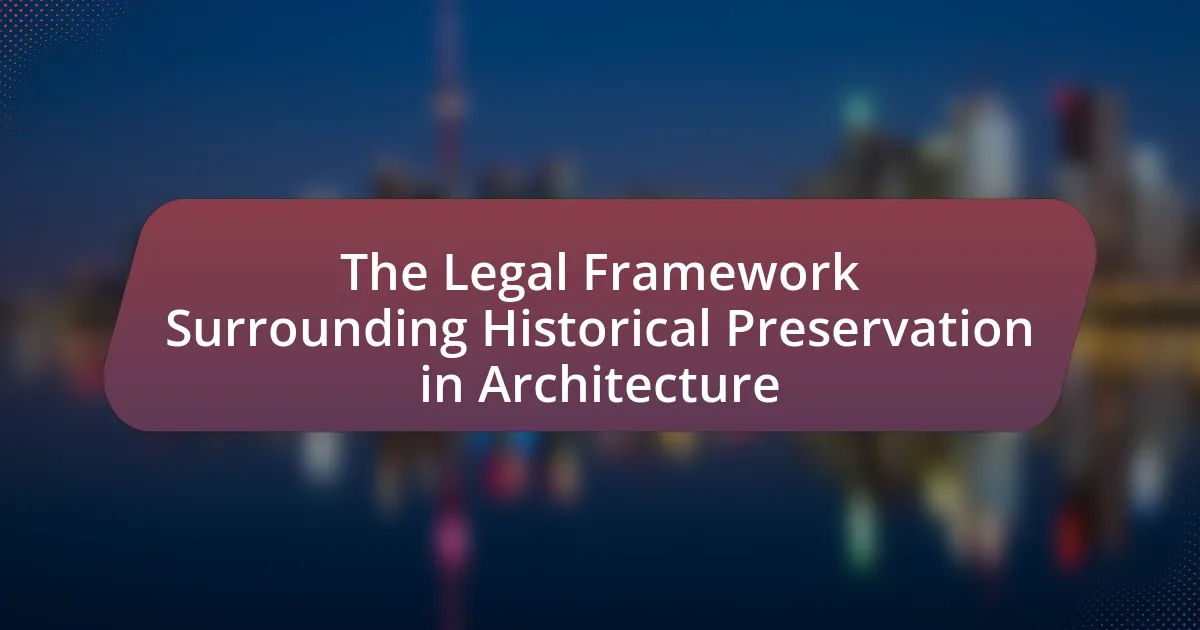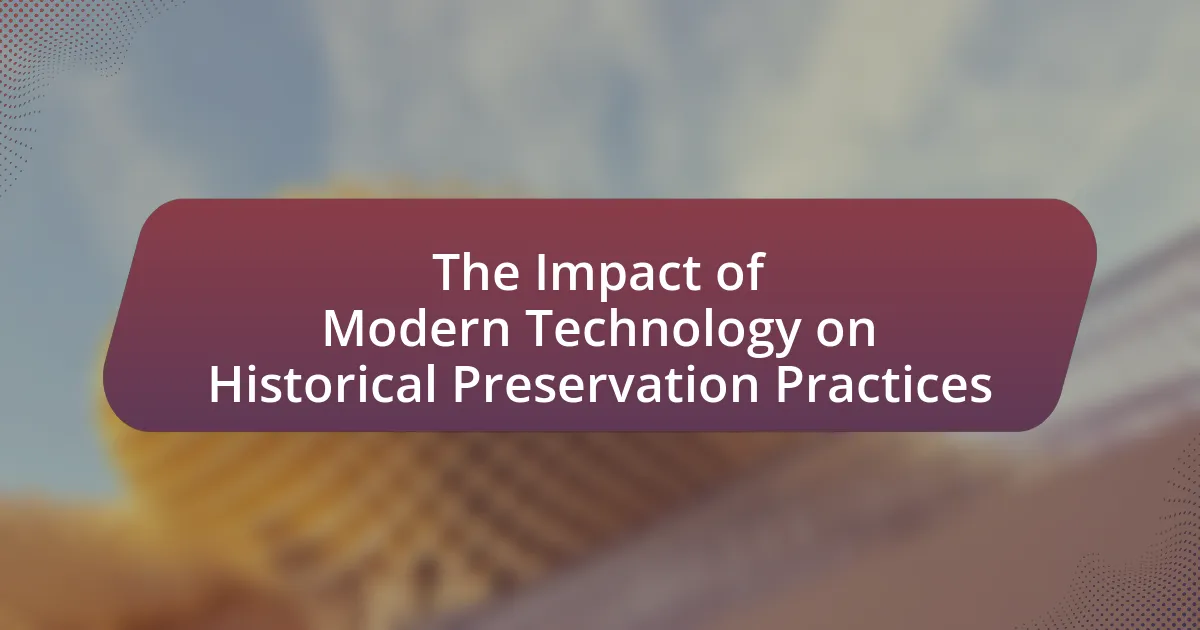The article focuses on the integration of new architecture with historical preservation, emphasizing the importance of maintaining cultural and architectural significance while modernizing spaces. It explores methods for blending contemporary design with historical elements, highlighting successful case studies such as the Tate Modern and the High Line. Key considerations include preserving structural integrity, aesthetic design, and community identity, as well as the role of technology and sustainable practices in enhancing historical sites. The article also addresses challenges faced in this integration and the significance of community engagement in preservation efforts.
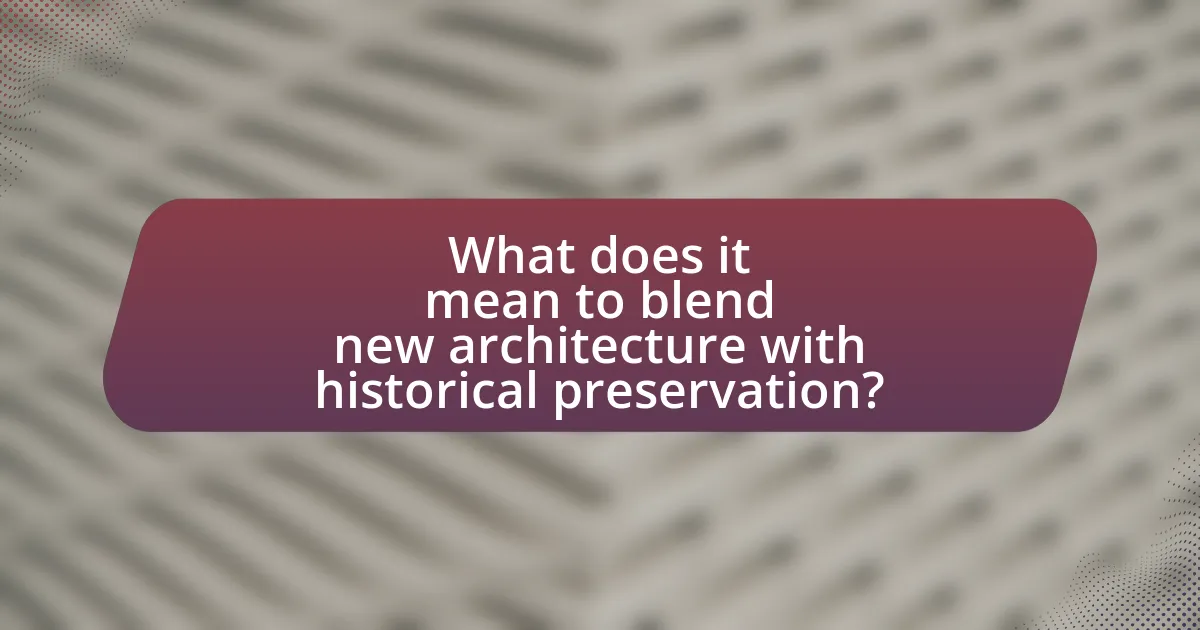
What does it mean to blend new architecture with historical preservation?
Blending new architecture with historical preservation means integrating contemporary design elements into existing historical structures while maintaining their cultural and architectural significance. This approach allows for the modernization of facilities and spaces, ensuring they meet current functional needs without compromising their historical integrity. For example, the renovation of the Tate Modern in London, which transformed a former power station into a contemporary art museum, exemplifies this blend by preserving the building’s industrial character while introducing modern art spaces. This practice not only enhances usability but also fosters a dialogue between the past and present, enriching the urban landscape.
How can modern design principles be integrated with historical elements?
Modern design principles can be integrated with historical elements by employing a contextual approach that respects the original architecture while introducing contemporary materials and techniques. This integration can be achieved through adaptive reuse, where existing structures are renovated to serve new purposes while maintaining their historical significance. For example, the High Line in New York City transformed an abandoned railway into a public park, preserving its historical context while incorporating modern landscaping and design features. Additionally, using modern technologies, such as energy-efficient systems, can enhance the functionality of historical buildings without compromising their aesthetic integrity. This method not only honors the past but also meets current sustainability standards, demonstrating a successful blend of old and new.
What are the key characteristics of historical architecture that should be preserved?
The key characteristics of historical architecture that should be preserved include structural integrity, aesthetic design, cultural significance, and craftsmanship. Structural integrity ensures that the building remains safe and functional, while aesthetic design reflects the artistic values and styles of the period in which it was built. Cultural significance highlights the historical context and the stories associated with the architecture, making it an essential part of community identity. Craftsmanship showcases the skills and techniques used by artisans of the time, which may include unique materials and construction methods. These characteristics are vital for maintaining the authenticity and heritage of historical sites, as evidenced by preservation guidelines established by organizations such as the National Park Service, which emphasize the importance of these elements in their preservation standards.
How do contemporary materials and techniques complement historical structures?
Contemporary materials and techniques enhance historical structures by providing improved durability, energy efficiency, and aesthetic integration. For instance, the use of glass and steel in restoration projects allows for natural light to penetrate while maintaining the original architectural integrity, as seen in the Louvre Pyramid designed by I.M. Pei, which harmonizes modern design with the historic Louvre Museum. Additionally, advanced preservation techniques, such as 3D scanning and printing, enable precise restoration of intricate details that may have been lost over time, ensuring that historical accuracy is maintained while incorporating modern functionality. These methods not only respect the past but also adapt structures for contemporary use, thereby extending their lifespan and relevance in today’s architectural landscape.
Why is it important to preserve historical architecture in modern urban planning?
Preserving historical architecture in modern urban planning is crucial for maintaining cultural identity and heritage. Historical buildings serve as tangible links to the past, reflecting the unique history and character of a community. For instance, cities like Paris and Rome have successfully integrated their historical structures into contemporary urban designs, enhancing tourism and local pride. Furthermore, studies show that neighborhoods with preserved historical architecture often experience increased property values and economic growth, as they attract residents and businesses seeking a distinctive environment. This integration fosters a sense of continuity and belonging, making urban spaces more vibrant and livable.
What cultural and educational benefits arise from preserving historical buildings?
Preserving historical buildings provides significant cultural and educational benefits by maintaining a tangible connection to the past and fostering community identity. These structures serve as physical reminders of historical events, architectural styles, and cultural practices, allowing individuals to engage with their heritage. For instance, studies show that heritage tourism, which often centers around historical buildings, can boost local economies while educating visitors about the region’s history and culture. Furthermore, educational programs associated with these sites, such as guided tours and workshops, enhance public understanding of historical contexts and architectural significance, thereby enriching the community’s cultural fabric.
How does historical preservation contribute to community identity?
Historical preservation contributes to community identity by maintaining and showcasing the unique cultural heritage and historical narratives of a place. This preservation fosters a sense of belonging and continuity among residents, as it allows them to connect with their past and understand their community’s evolution. For instance, studies have shown that communities with preserved historical sites often experience increased civic pride and engagement, as these sites serve as focal points for local events and gatherings. Furthermore, according to the National Trust for Historic Preservation, communities that invest in historical preservation see economic benefits, such as increased tourism and property values, which further solidify their identity and attract new residents who value cultural heritage.
What challenges arise when blending new architecture with historical preservation?
Blending new architecture with historical preservation presents challenges such as maintaining aesthetic harmony, structural integrity, and compliance with regulations. Aesthetic harmony is crucial as new designs must complement existing historical styles to avoid visual discord. Structural integrity issues arise when integrating modern materials and techniques with older buildings, which may not support contemporary loads or energy efficiency standards. Compliance with preservation regulations, such as those enforced by the National Historic Preservation Act, can limit design options and require extensive review processes. These challenges necessitate careful planning and collaboration among architects, preservationists, and local authorities to achieve a successful integration of old and new.
What are the common conflicts between modern design and historical integrity?
Common conflicts between modern design and historical integrity include aesthetic discrepancies, material incompatibility, and functional challenges. Aesthetic discrepancies arise when contemporary styles clash with traditional architectural forms, leading to visual discord. Material incompatibility occurs when modern materials, such as glass and steel, do not align with the original materials used in historical structures, potentially compromising their authenticity. Functional challenges often emerge as modern needs, such as accessibility and energy efficiency, require alterations that may detract from the historical character of a building. These conflicts highlight the tension between innovation and preservation in architectural practices.
How can architects navigate regulatory and zoning issues related to preservation?
Architects can navigate regulatory and zoning issues related to preservation by thoroughly understanding local laws and engaging with stakeholders early in the design process. Familiarity with the specific preservation ordinances, zoning codes, and historical designations in their area allows architects to identify constraints and opportunities for their projects. Engaging with local preservation boards, community groups, and government agencies fosters collaboration and can lead to more favorable outcomes. For instance, the National Trust for Historic Preservation emphasizes the importance of community involvement in preservation efforts, which can help architects align their designs with community values and regulatory expectations.
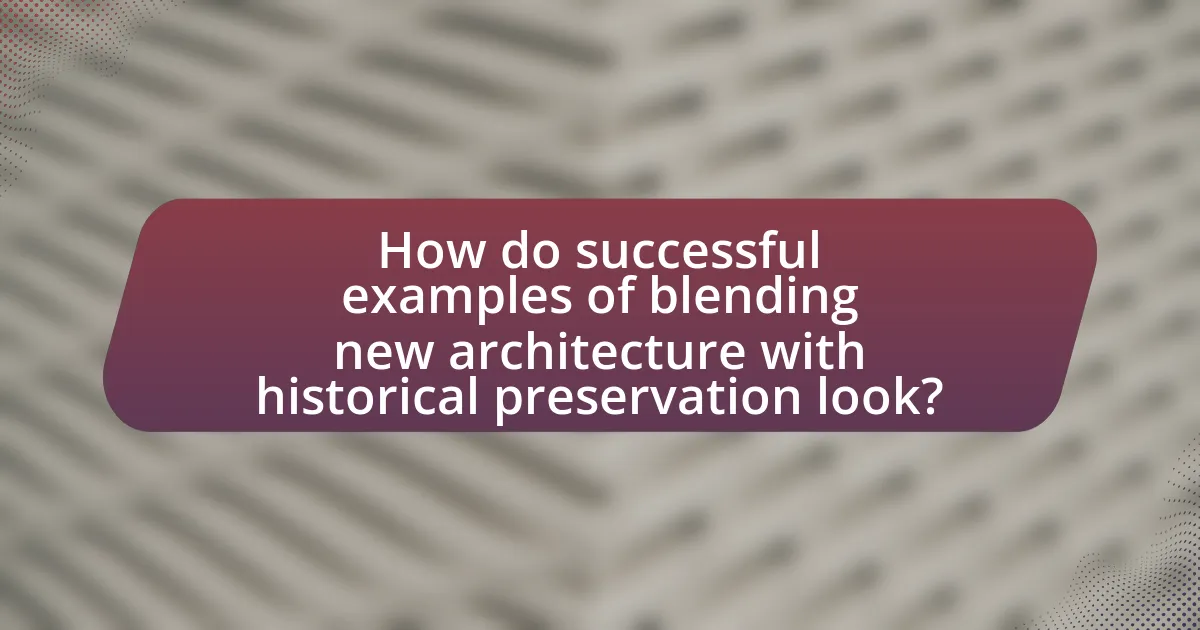
How do successful examples of blending new architecture with historical preservation look?
Successful examples of blending new architecture with historical preservation often feature modern designs that complement and enhance the existing historical structures. For instance, the Louvre Pyramid in Paris, designed by I.M. Pei, integrates a contemporary glass structure with the historic Louvre Museum, creating a harmonious dialogue between old and new. This approach respects the historical context while introducing innovative materials and design elements, demonstrating that modern architecture can coexist with and elevate historical sites. The integration of sustainable technologies in these projects, such as energy-efficient systems, further exemplifies how new architecture can contribute positively to the preservation of historical integrity while meeting contemporary needs.
What are some notable case studies of successful integration?
Notable case studies of successful integration in blending new architecture with historical preservation include the Tate Modern in London, which transformed a former power station into a contemporary art museum while retaining its industrial character. Another example is the High Line in New York City, where an abandoned elevated railway was repurposed into a public park, preserving its historical structure while integrating modern landscaping. Additionally, the Louvre Abu Dhabi showcases a modern architectural design that harmonizes with the cultural heritage of the region, featuring a dome that reflects traditional Islamic architecture. These projects demonstrate effective strategies for merging contemporary design with historical context, enhancing both functionality and aesthetic value.
How did specific projects overcome challenges in blending styles?
Specific projects overcame challenges in blending styles by employing adaptive reuse strategies and collaborative design processes. For instance, the High Line in New York City transformed an abandoned elevated railway into a public park, integrating modern landscaping with the historical structure, which preserved its industrial character while introducing contemporary elements. This approach was supported by community engagement and input from landscape architects, ensuring that the new design respected the site’s history. Similarly, the Louvre Abu Dhabi utilized a modern dome structure that harmonizes with traditional Arabic architecture, demonstrating how innovative engineering can coexist with cultural heritage. These projects exemplify successful blending by prioritizing both preservation and modern functionality, backed by thorough research and stakeholder collaboration.
What lessons can be learned from these successful examples?
Successful examples of blending new architecture with historical preservation teach the importance of context-sensitive design. These projects demonstrate that integrating modern elements with historical structures can enhance cultural significance while meeting contemporary needs. For instance, the renovation of the Tate Modern in London, which transformed a former power station into a museum, illustrates how adaptive reuse can preserve historical integrity while providing functional space. This approach not only respects the past but also revitalizes urban areas, as seen in the High Line project in New York City, which repurposed an old railway into a public park, fostering community engagement and economic development.
What role do community stakeholders play in these projects?
Community stakeholders play a crucial role in projects that blend new architecture with historical preservation by providing insights, resources, and support that align with local values and needs. Their involvement ensures that the design process reflects the community’s historical context and cultural significance, fostering a sense of ownership and pride among residents. For instance, studies have shown that community engagement in urban development leads to higher satisfaction rates and better project outcomes, as stakeholders contribute their unique perspectives and expertise. This collaborative approach not only enhances the project’s relevance but also promotes sustainable practices that respect the historical fabric of the area.
How can public input shape the design process for preservation projects?
Public input can significantly shape the design process for preservation projects by ensuring that community values and historical significance are integrated into the planning. Engaging the public through surveys, workshops, and meetings allows stakeholders to express their perspectives, which can lead to designs that reflect local heritage and meet community needs. For instance, the National Trust for Historic Preservation emphasizes that involving the community can enhance project acceptance and foster a sense of ownership, ultimately leading to more sustainable preservation outcomes.
What are the benefits of involving local artisans and craftsmen in the design process?
Involving local artisans and craftsmen in the design process enhances cultural authenticity and craftsmanship quality. Their deep understanding of local materials and traditional techniques ensures that designs resonate with the community’s heritage, fostering a sense of identity and continuity. For instance, studies show that projects incorporating local craftsmanship often achieve higher community acceptance and satisfaction, as they reflect the unique characteristics of the area. Additionally, collaboration with these skilled individuals can lead to innovative solutions that blend modern needs with historical context, ultimately enriching the architectural landscape.
How can technology aid in the preservation of historical architecture?
Technology aids in the preservation of historical architecture through advanced methods such as 3D scanning, digital modeling, and augmented reality. These technologies enable precise documentation of existing structures, allowing for accurate restoration and reconstruction efforts. For instance, 3D scanning captures detailed measurements and conditions of buildings, which can be used to create digital archives that inform future preservation strategies. Additionally, augmented reality can provide immersive experiences that educate the public about historical sites while ensuring their protection. The use of these technologies has been validated by various preservation projects, demonstrating their effectiveness in maintaining the integrity of historical architecture while integrating modern design principles.
What innovative technologies are being used in restoration and preservation efforts?
Innovative technologies used in restoration and preservation efforts include 3D scanning, digital modeling, and advanced materials like nanotechnology. 3D scanning allows for precise documentation of historical structures, capturing intricate details that can be used for accurate restoration. Digital modeling enables architects and preservationists to visualize potential changes and assess the impact on historical integrity. Advanced materials, such as nanotechnology, enhance the durability and longevity of restored elements while maintaining aesthetic qualities. These technologies collectively improve the efficiency and effectiveness of preservation projects, ensuring that historical sites are accurately maintained for future generations.
How does digital modeling enhance the design process for blended architecture?
Digital modeling enhances the design process for blended architecture by enabling precise visualization and simulation of architectural elements, allowing designers to integrate modern structures with historical contexts effectively. This technology facilitates the exploration of various design options, ensuring that new constructions harmonize with existing heritage sites. For instance, tools like Building Information Modeling (BIM) provide detailed data on structural integrity and material compatibility, which is crucial for maintaining the authenticity of historical architecture while accommodating contemporary needs. Studies have shown that projects utilizing digital modeling techniques experience a reduction in design errors and improved stakeholder communication, ultimately leading to more successful outcomes in preserving historical integrity while embracing innovative design.
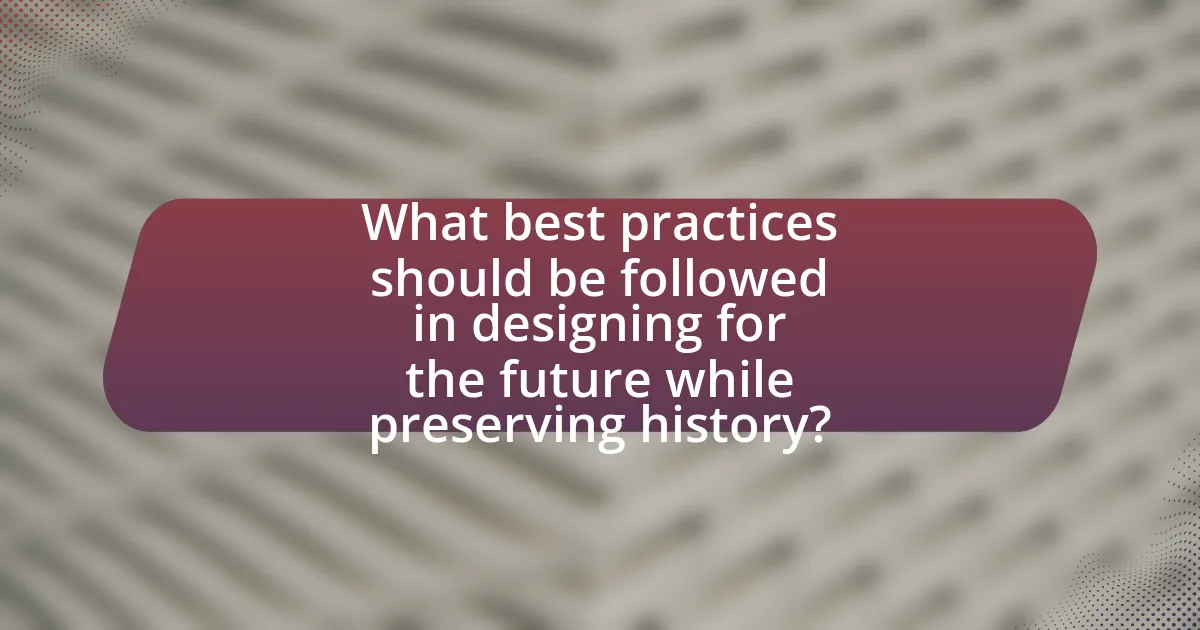
What best practices should be followed in designing for the future while preserving history?
To design for the future while preserving history, best practices include integrating modern technology with historical context, ensuring adaptive reuse of existing structures, and engaging community stakeholders in the design process. Integrating modern technology allows for energy efficiency and sustainability, which can enhance historical sites without compromising their integrity. Adaptive reuse involves repurposing old buildings for new functions, preserving their historical significance while meeting contemporary needs; for example, converting a historic factory into residential lofts maintains the building’s character. Engaging community stakeholders ensures that the design reflects local values and history, fostering a sense of ownership and continuity. These practices are supported by the National Trust for Historic Preservation, which emphasizes the importance of balancing innovation with heritage conservation.
What guidelines should architects consider when starting a preservation project?
Architects should consider the significance of the historical context, structural integrity, and community impact when starting a preservation project. Understanding the historical context ensures that the architectural elements reflect the original design and cultural importance, which is crucial for maintaining authenticity. Assessing structural integrity allows architects to identify necessary repairs and modifications while preserving essential features. Additionally, evaluating community impact helps architects engage stakeholders and ensure that the project meets contemporary needs without compromising historical value. These guidelines align with the Secretary of the Interior’s Standards for the Treatment of Historic Properties, which emphasize the importance of preserving the character-defining features of historic buildings.
How can architects balance aesthetic appeal with structural integrity?
Architects can balance aesthetic appeal with structural integrity by employing innovative design techniques that integrate both visual elements and engineering principles. For instance, the use of advanced materials such as high-strength concrete and steel allows for more flexible and creative designs while maintaining safety standards. Additionally, architects often utilize computer-aided design (CAD) software to simulate structural performance, ensuring that aesthetic choices do not compromise the building’s stability. Historical examples, such as the Sydney Opera House, demonstrate how architects can achieve iconic designs that also meet rigorous structural requirements, showcasing that thoughtful integration of aesthetics and engineering is both possible and effective.
What sustainable practices can be incorporated into preservation efforts?
Sustainable practices that can be incorporated into preservation efforts include the use of renewable materials, energy-efficient systems, and adaptive reuse of existing structures. Utilizing renewable materials, such as reclaimed wood or recycled metals, reduces the environmental impact associated with new resource extraction. Energy-efficient systems, like solar panels and high-performance insulation, minimize energy consumption and lower carbon footprints. Adaptive reuse, which involves repurposing old buildings for new functions, preserves historical integrity while reducing waste and the need for new construction. According to the National Trust for Historic Preservation, adaptive reuse can save up to 50% of the embodied energy compared to new construction, highlighting its effectiveness in sustainable preservation.
What are the key considerations for engaging with local communities during the design process?
Key considerations for engaging with local communities during the design process include understanding community needs, fostering open communication, and ensuring inclusivity. Engaging with local communities requires identifying their specific needs and preferences, which can be achieved through surveys, focus groups, and public meetings. Open communication channels allow for ongoing dialogue, enabling community members to voice their concerns and suggestions throughout the design process. Inclusivity ensures that diverse voices, including marginalized groups, are represented, which can enhance the project’s acceptance and relevance. Research indicates that projects involving community engagement are more likely to succeed, as they reflect the values and aspirations of the local population, ultimately leading to better outcomes in terms of social cohesion and satisfaction.
How can architects ensure that community needs are met in preservation projects?
Architects can ensure that community needs are met in preservation projects by actively engaging with local stakeholders throughout the design process. This engagement includes conducting surveys, holding public meetings, and collaborating with community organizations to gather input on the historical significance and desired outcomes of the project. Research indicates that projects incorporating community feedback are more likely to succeed and be embraced by residents, as seen in the case of the revitalization of the historic downtown area in Portland, Oregon, where community involvement led to a design that reflected local values and needs.
What strategies can be employed to foster ongoing community support for preservation initiatives?
To foster ongoing community support for preservation initiatives, engaging the community through education and participatory activities is essential. Educational programs that highlight the historical significance and benefits of preservation can increase awareness and appreciation among community members. For instance, workshops, guided tours, and interactive events can help residents understand the value of their local heritage. Additionally, involving community members in decision-making processes regarding preservation projects ensures that their voices are heard and their needs are met, fostering a sense of ownership and responsibility. Research indicates that communities with active participation in preservation efforts report higher levels of support and commitment to these initiatives, as seen in studies conducted by the National Trust for Historic Preservation, which emphasize the importance of community engagement in successful preservation efforts.
What practical tips can architects follow to successfully blend new architecture with historical preservation?
Architects can successfully blend new architecture with historical preservation by prioritizing contextual design, which involves understanding the historical significance and architectural style of existing structures. This approach ensures that new developments complement rather than overshadow historical elements. For instance, using materials and colors that harmonize with the original architecture can create visual continuity. Additionally, engaging with local communities and stakeholders during the design process fosters a sense of ownership and respect for historical contexts. Research indicates that projects incorporating community input and historical awareness tend to achieve greater acceptance and success, as seen in the revitalization efforts in cities like Boston, where new constructions have been designed to reflect the character of historic neighborhoods.



